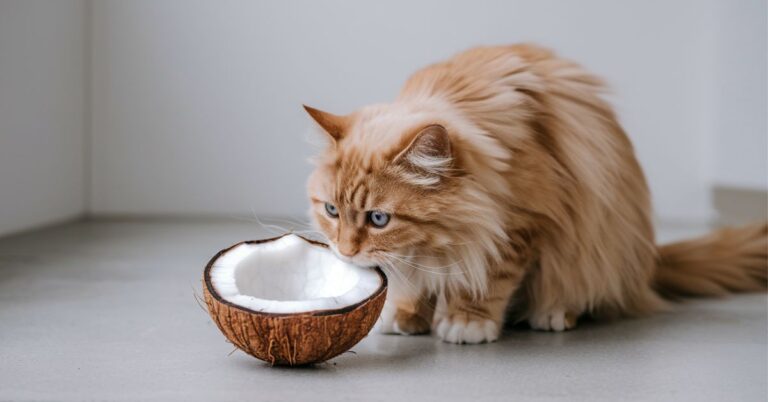Can Cats Eat Seaweed? Vets Reveal the Surprising Answer!
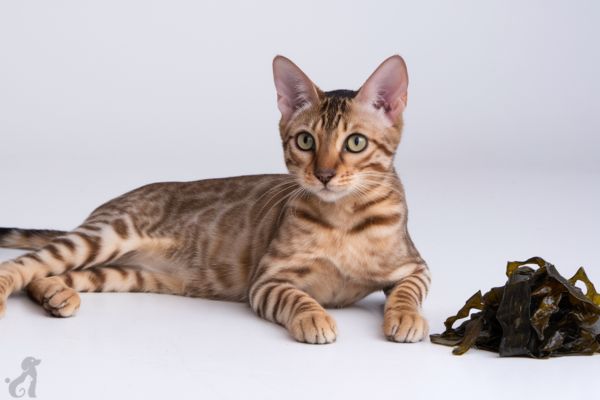
There are some foods you have never seen a cat eat, and if you want to give that food to your cat, you will first have to think about whether it is good for them. One of these foods is seaweed.
Before giving your cat seaweed, it is important to know the answer to the question: Can cats eat seaweed? and whether eating it can negatively affect their health. Cats can eat seaweed in moderation, as it contains proteins, fiber, vitamins, trace minerals, and essential fatty acids.
But many cat owners don’t know whether it’s good for their cats to eat it. There is no doubt that seaweed has many health benefits, but that does not mean that we should consider it a natural part of a cat’s diet.
Seaweed cannot be a substitute for a cat’s balanced diet but should be used as an additional treat because it provides the cat with additional nutrients.
When I offer my cats plain seaweed, some are curious to eat it while others show no interest in it. Every cat is unique, so don’t be surprised if your cat isn’t interested in eating seaweed.
By the way, cats can get many benefits from eating seaweed, but there are also some concerns, such as the amount of seaweed and the harmful ingredients it contains, and these ingredients are especially hidden in processed seaweed.
In all our research, we haven’t found any species of seaweed that are deadly to cats. Seaweed is a safe food for cats, but some cats still don’t like it and will refuse to eat it outright. If she refuses, don’t worry; her refusal won’t negatively affect her health.
There are many types of seaweed that you can safely give to your cat in small amounts, such as Acadian Sea Kelp, Dulse, Irish Moss, Nori, Kombu, Wakame, and Sea Lettuce.
Is seaweed good for cats?
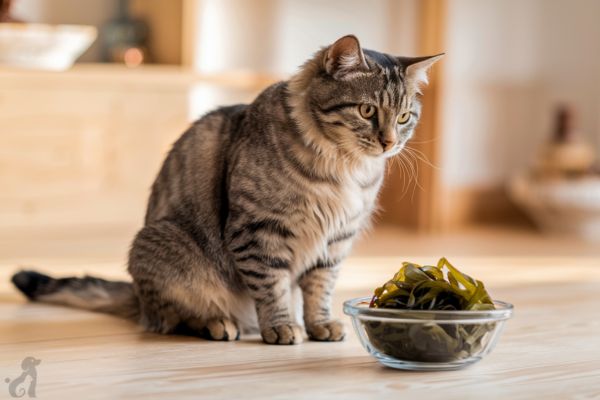
If you give your cat seaweed in small amounts, it is better for him and will provide many health benefits, but remember that seaweed should not be considered a replacement for a balanced diet.
Seaweed contains many prebiotics, which are important in developing the cat’s intestines. It also contains a large amount of fiber, which keeps the cat’s intestines moving and reduces the chances of constipation.
In addition, seaweed also contains many amino acids to keep a cat’s coat and skin healthy. Cats that get seaweed supplements in their food might have better-looking and healthier coats over time.
Seaweed not only contains many vitamins and minerals but also many antioxidants that decrease the number of free radicals in your cat and can also help your cat decrease inflammation if it has any.
If your cat wants to get these benefits, it is not necessary for him to need a large amount of seaweed, but he can get these benefits even by consuming a small amount of seaweed.
What should I be aware of when offering seaweed to my cat?
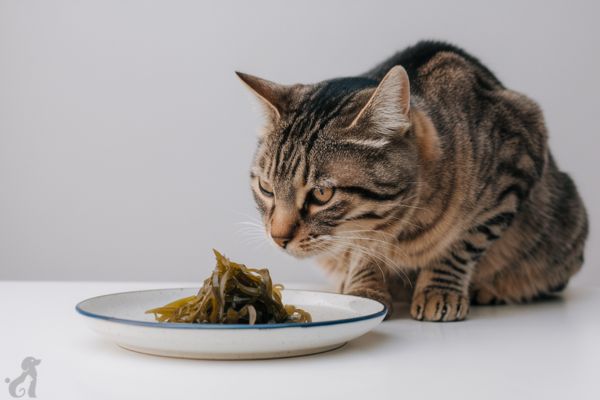
Any food, including seaweed, that you are giving to your cat for the first time can be dangerous for your cat if you offer it to your cat in large quantities the first time.
The main reason why seaweed is dangerous for cats is the iodine it contains, which can affect a cat’s thyroid function. Therefore, we advise you to avoid giving your cat seaweed if it has hyperthyroidism.
How to Safely Feed Seaweed to a Cat?
When you plan to give your cat any new food, such as coconut or seaweed, always consult your veterinarian. If your doctor allows, consider using plain, unsalted seaweed such as nori, kelp, and wakame. Before giving seaweed to your cat, prepare it well.
For example, if it is dry, soak it in water for a while so that you don’t have to face any diseases like stomach expansion in your cat. When giving any food, including seaweed, to your cat for the first time, keep the amount small.
If there is no change in your cat’s behavior after eating it, then you can increase the amount slightly, but it is best to keep the initial amount very small.
As I have told you before, whenever you give your cat seaweed, you should keep in mind that it is just a treat for your cat and not a regular part of its diet.
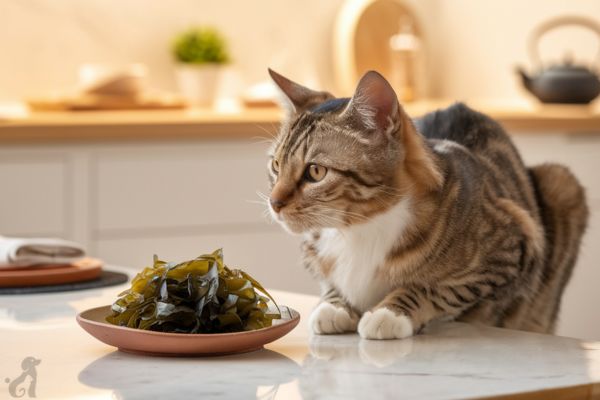
Benefits Of Seaweed For Cats
You’ve learned a lot of important things about cats and seaweed. Now, we’ll learn about the health benefits of seaweed for your cat and tell you which bioactive compounds and nutrients seaweed is packed with.
Great Source of Iodine
The vitamins and minerals in seaweed and marine plants provide many health benefits to cats. Seaweed contains a large amount of iodine, which regulates cats’ metabolism and also supports cats’ thyroid function.
Some palatable seaweeds for cats that contain iodine are elkhorn seamoss, a red seaweed, and kelp, a brown seaweed. Iodine is needed for the thyroid to work well and also helps in other body functions.
If a cat’s diet is too low or missing important nutrients, it can lead to hyperthyroidism, a common hormone problem in older cats.
Seaweed for Digestive Issues
If your cat has indigestion, meaning that whenever it eats something, it cannot digest it properly, then add seaweed to your cat’s food. This will not only relieve digestive problems but will also reduce the discomfort in the stomach to a great extent.
Antioxidants and Cell Repair
Seaweed and marine plants contain antioxidants. Antioxidants protect cells and support the immune system by reducing damage from free radicals that come from air pollution, chemicals, and the environment.
When cats consume seaweed, their cells become adept at self-repair and fighting off the worst effects. This makes cats less likely to suffer from aging-related health problems.
Improving Stool Firmness
If you feed your cat seaweed, it will keep your cat’s stool firm, and you will be able to handle it more easily.
Dental Benefits
Seaweed is good for cleaning teeth due to the enzyme Bacillus licheniformis. This enzyme stops bacteria from building up on plaque, which helps prevent tooth decay.
Nutritional Value of Seaweed
Seaweed contains many minerals and vitamins. When your cat eats it, it will grow very quickly. Along with vitamins and minerals, seaweed also contains many chelated substances that help to reduce your cat’s discomfort.
Prebiotics and Gut Health
The prebiotics in seaweed improve gut health in most mammals. Prebiotics support the good bacteria in a cat’s belly, making it easier to manage bad bacteria.
Remedy for Heartburn
If your cat is suffering from heartburn, seaweed is also an excellent remedy.
Enhancing Fur and Skin Health
Using seaweed can help your cat improve its fur texture and appearance and also maintain a healthy heart. So, using seaweed will also groom our cat, as well as give it a wonderful coat and skin due to the presence of omega-3 fatty acids.
EPA and DHA are two important omega-3 fatty acids, which are essential for a cat’s health. If your cat has inflammation or you want to keep its joints healthy, add seaweed to its food. Additionally, if your cat’s skin is often dry or inflamed, seaweed can also solve this problem.
One of my cats, whom I affectionately call Zephyr, has been experiencing dry skin issues for the past few days. I added seaweed supplements to her diet and within a few days I saw a noticeable improvement in the texture of her coat. Her fur will be shiny and soft after a few weeks of using seaweed.
Dangers of Feeding Cats Seaweed
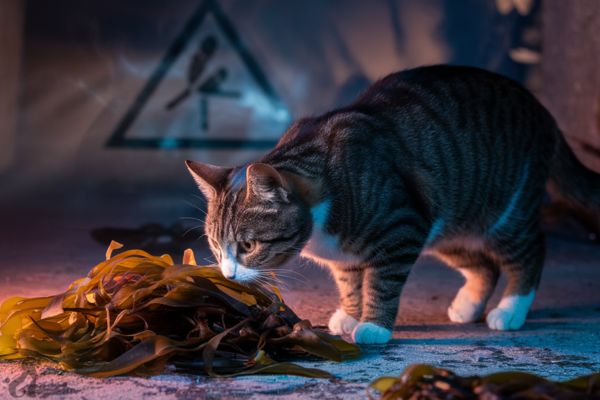
Along with the benefits, there are some disadvantages to your cat eating seaweed that you should be aware of. Whenever you think about adding seaweed to your cat’s diet, it’s important to first learn about its dangers.
High Sodium Content
Seaweed is high in sodium, and a cat’s kidney cannot process salt like a human kidney. When cats consume too much salt, it can lead to dehydration, increased thirst, and increased urination, and in some cases, excessive salt consumption can lead to sodium ion poisoning.
If your cat vomits frequently or has diarrhea, lethargy, and tremors, it may be a sign that he has eaten too much salt.
Another important thing to remember here is that some seafood can only be consumed by humans because it contains excess salt, and if ingested by a cat, it can cause health problems.
Risk of Heavy Metals
Seaweeds naturally gather metals such as lead, mercury, and arsenic from the water they grow in. Consumption of these heavy metals can be toxic to your cat.
She may have an upset stomach or suffer from severe neurological problems, depending on how much of this metal she has consumed.
The best solution to avoid this risk is to source your seaweed from suppliers who carefully test their products for metal contamination before shipping them anywhere.
Expansion in Stomach
When seaweed touches the stomach fluids, it can expand very quickly, which is why dried seaweed is considered a particular threat. The expansion might lead to blockages in the stomach and intestines, which can be dangerous.
This problem happens with seaweed products that are dehydrated and compressed. There are some signs of blockage, such as your cat vomiting frequently, having a poor appetite, having stomach pain, and often complaining of constipation.
To avoid these risks, it is important that whenever you offer seaweed to your cat, soak it in water for a while to rehydrate it, it softens the texture and makes it safer for them to digest. And keep the quantity small to reduce the chance of it expanding to a difficult size.
How to Know if Your Cat Has Overeaten Seaweed?

Never assume that everything is fine after giving your cat seaweed. Instead, I will tell you some signs that you can look for to determine if your cat has eaten too much seaweed. Your cat may develop diseases like vomiting or diarrhea and become lethargic or unusually tired.
Symptoms of stomach upset, difficulty breathing, panting, or drooling are some of the signs that can help you determine that your feline friend has eaten too much seaweed.
Can Cats Eat Seaweed Sheets?
If the seaweed sheets are made of plain and simple seaweed, cats can eat them. In addition, the seaweed sheet should be salt-free and should not contain any additives such as oils, spices, flavorings, or preservatives. Many companies sell flat, packaged seaweed sheets for quick and easy wrap-making. Always read the ingredient list to be sure there are no unsafe substances.
Can Cats Eat Nori?
First, you need to know what Nori is. Nori is a type of seaweed that Japanese people use in their cuisine. Nori is widely used in sushi rolls and seaweed gelatin. One of the reasons why nori is so popular is that it tastes delicious and is very nutritious.
It is a safe food for your cat because it is low in calories and contains no spices or additives that could harm your cat’s health.
Nori is rich in protein, fiber, iodine, iron, magnesium, and many vitamins, (such as vitamins A, B, C, and B12) and some minerals, such as zinc and copper. Whenever I think about giving my cat Nori, I make sure the nori is plain and unsalted.
Can Cats Eat Kelp?
Kelp is a large type of seaweed and is part of the brown algae family, and you will often see it underwater in forests. Kelp is quite popular because it contains many nutrients. Kelp in particular contains a large amount of iodine, which helps improve thyroid health.
Apart from this, it also contains amino acids and some essential fatty acids. When it comes to vitamins, vitamins A, B, E, D, and K, minerals like calcium, magnesium, and iron are also included in the kelp.
You can sprinkle a small amount of kelp into your cat’s regular food as it is in powder form, however, be careful of the amount while sprinkling it as adding too much powder to the food can harm cats.
Can Cats Eat Wakame?
Wakame is also a type of seaweed and is usually green in color. Many Japanese use it in their cuisine, such as miso soup. Wakame without salt can be a light and nutritious treat. It includes a mix of vitamins, minerals, and antioxidants for the good health of your cat.
Before giving your cat dried wakame, soak it in water so that it is properly rehydrated, then cut it into small pieces and offer it to your cat. Make sure it does not contain any dressing or seasoning.
Seaweed to Avoid
As we have told you before, seaweed is safe for cats and they can eat it in moderation, but there are some seaweed-related products that you should avoid giving to your cat.
The short point is that you should only give your cat seaweed that is plain and does not contain any flavoring or seasoning. You should know that if your cat eats too much salt, wasabi, or other spices, its health may deteriorate.
Seaweed snacks like chips and crackers have salt and calories that aren’t healthy for your cat. This is why we recommend that you do not give your cat a seaweed snack. Whenever you buy seaweed for your cat, try to make sure it is plain, not processed or flavored.
Additional Tips Based on Experience:
- A small amount of iodine is very important for cats or any pet, but if this amount is excessive, it can cause thyroid problems in cats. Therefore, before feeding seaweed to your cat or any pet, make sure that it is low in iodine.
- Some processed seaweed products contain harmful chemicals that can negatively affect your cat’s digestive system or cause long-term health problems.
- When giving seaweed or any other food to your cat for the first time, keep the amount small so that you can easily see how your cat reacts to it. Sometimes, cats can have diarrhea or even vomit repeatedly when they eat something new due to their sensitive stomachs.
- As a pet owner, I would advise you to never give your cat dried seaweed. This can expand in your cat’s stomach and some cases cause discomfort or even blockage. Whenever you plan to give your cat dried seaweed, soak it in water for some time first.
- If you are concerned about giving your cat seaweed, consult your veterinarian first, and if your cat already has health problems such as kidney disease, hyperthyroidism, or obesity, you should definitely consult your veterinarian.
Alternatives to Feeding Your Cat Seaweed as a Snack
| Alternative | Details | Key Considerations |
|---|---|---|
| Cooked Fish | Eating salmon and tuna provides omega-3s that promote good skin and coat health. | Before giving fish to your cat, cook it thoroughly and the fish should be without salt, oil, or seasoning. Make sure to take out all the bones and serve them in small pieces as a rare treat. |
| Commercial Cat Treats | Available in various types, often fortified with essential vitamins and minerals. Some cater to specific health needs like urinary health or hairball control. | Choose high-quality treats with minimal additives and fillers. Avoid overfeeding, as treats should only complement a balanced diet. |
| Cooked Eggs | Eggs provide protein and essential amino acids beneficial for cats. | Cook without oil, butter, salt, or seasoning. Serve in very small amounts, as they are rich and may cause digestive issues if given in excess. |
| Cooked Meats | Lean meats like chicken and turkey are high in protein and low in fat, making them suitable for cats. | Cook thoroughly without added fats, seasonings, or sauces. Remove all bones and fatty parts. Serve in small portions to prevent digestive issues. |

